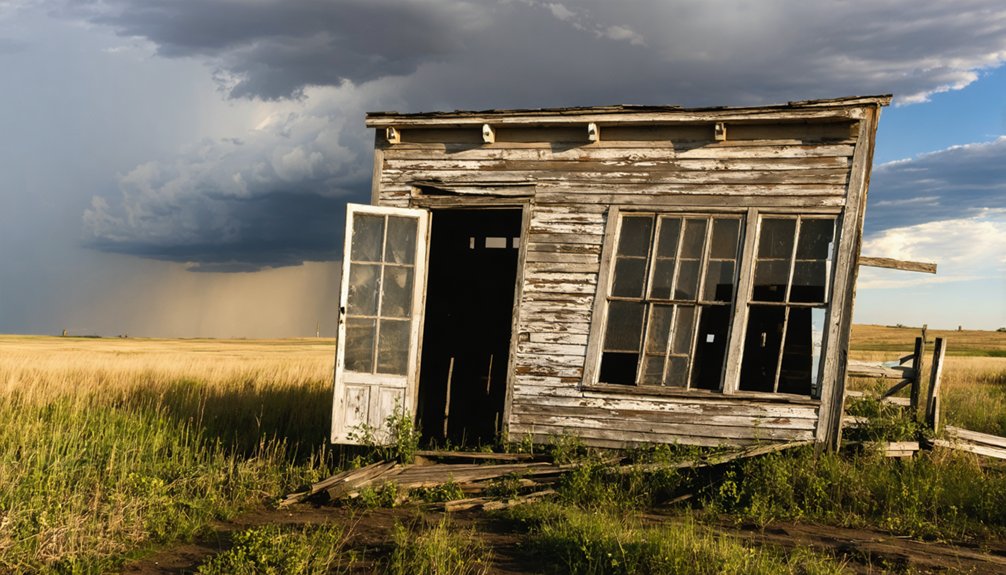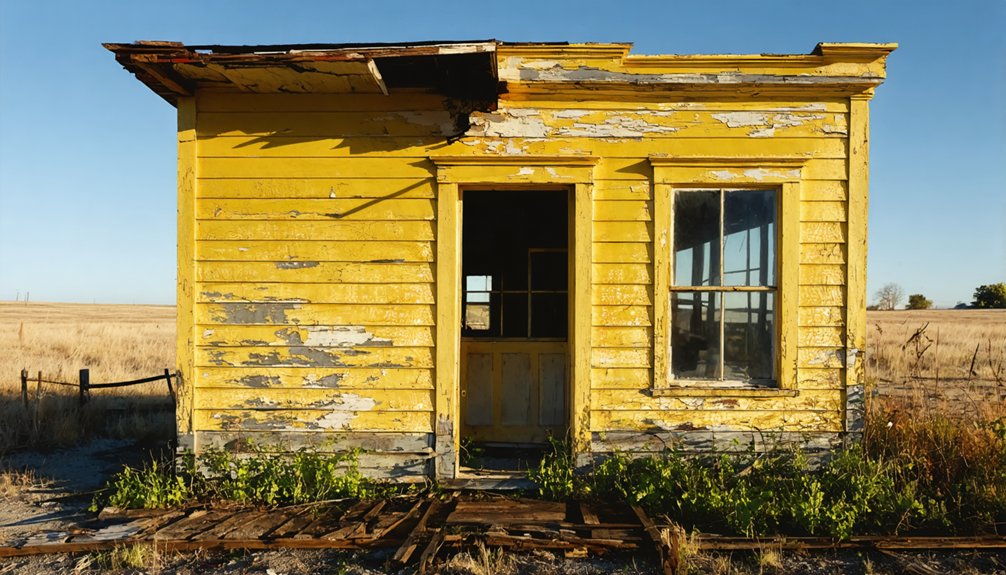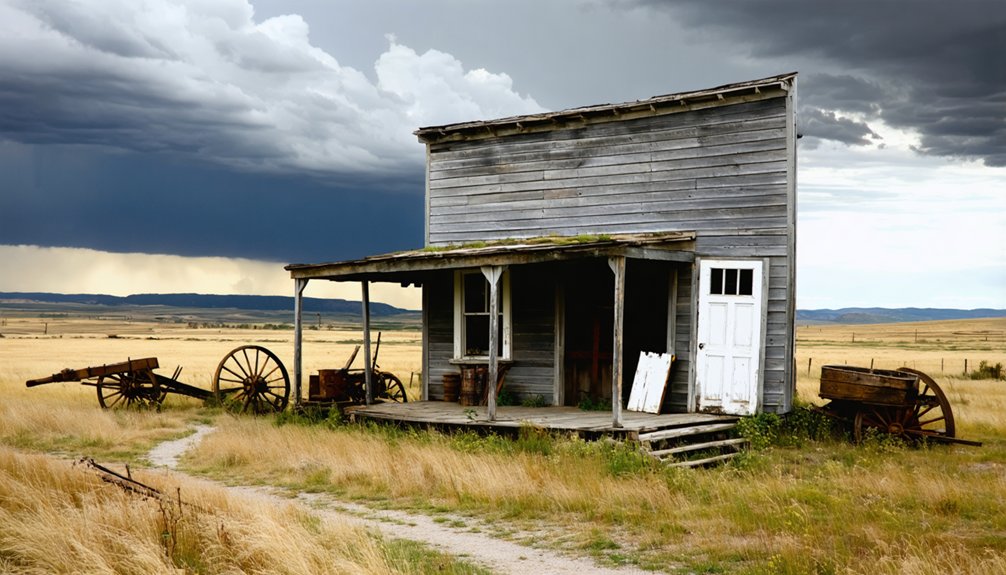You’ll find Golden West nestled in South Dakota’s Black Hills, where the Manuel brothers’ 1876 Homestake claim sparked a mining boom. The town flourished after 1916 when Golden West Telecommunications established operations, serving over 30 counties. Mining operations reached impressive depths of 6,800 feet by 1975, yielding substantial gold deposits through innovative cyanidization processes. Today, the abandoned site features deteriorating structures and mine shafts that hold countless stories of the Black Hills’ golden era.
Key Takeaways
- Golden West began operations in 1916 as a telecommunications hub serving over 30 counties and 70 communities in South Dakota.
- The site yielded 598.50 ounces of gold in 1905 and featured major mining shafts reaching depths of 6,800 feet by 1975.
- The community featured standardized housing units, company stores, and rural utility cooperatives that provided essential services to residents.
- Mining operations ceased due to economic changes, environmental regulations, and declining ore quality, leading to rapid population exodus.
- Today, only foundations, mine waste piles, and deteriorating ore bins remain, with no formal preservation efforts currently underway.
The Birth of a Mining Frontier
As the 1874 Custer Expedition revealed gold in Dakota Territory, a transformative mining frontier emerged in the Black Hills region.
You’d find thousands of prospectors flocking to creek beds by 1876, using placer mining techniques to extract loose gold through panning and sluicing. The search for richer deposits led miners to track the gold’s source upstream. The free milling techniques became standard practice for extracting gold from the region’s deposits. Despite government efforts to expel them, illegal prospectors continued flooding into the area.
The game-changer came in April 1876 when the Manuel brothers, along with Hank Harney and Alexander Engh, discovered the Homestake claim near Lead.
This marked the shift from simple placer mining to sophisticated hard rock operations. You can trace the region’s explosive growth through the rapid development of mining towns like Lead and Deadwood, where innovative mills crushed ore using mercury amalgamation to extract gold from the rich deposits beneath the Black Hills.
Golden West’s Peak Years
While gold fever transformed the Black Hills, a different kind of pioneering spirit took root in 1916 when Golden West Telecommunications began stringing telephone lines across western South Dakota’s vast prairies.
You’ll find that during its peak prosperity years, the company’s infrastructure evolved from simple telephone lines hung on fence posts to an extensive network serving over 30 counties and 70 communities. Rural neighbors relied on these vital lines strung along farm fences to stay connected.
The economic boom that followed Golden West’s incorporation as a cooperative in 1952 brought transformative changes to rural South Dakota.
Despite challenges like the Great Depression and two World Wars, you’d have witnessed the cooperative’s remarkable expansion of services, from basic telephony to advanced fiber optics.
Golden West’s commitment to connecting isolated communities created lasting economic benefits, establishing essential communication lifelines across Native American reservations and remote settlements.
Today, the cooperative continues to modernize its infrastructure through a comprehensive 64 exchanges upgrade that will bring enhanced reliability to its telecommunications services.
Mining Operations and Infrastructure
During the height of Golden West’s mining operations, you’d find a complex network of surface and underground workings dedicated to gold and silver extraction.
According to historical records, the mine yielded impressive quantities, including a remarkable 598.50 ounces of gold in 1905.
The mine’s infrastructure included several major shafts, with the deepest reaching an impressive 6,800 feet by 1975. You’d see innovative mining methods evolve from basic mercury amalgamation to more efficient cyanidization processes, which boosted gold recovery rates to 94%. Safety measures included required use of protective gear for all workers entering the mine shafts.
Underground, you’d encounter compressed air locomotives replacing old horse-drawn carts, hauling ore through an intricate system of levels and winzes.
The ore processing system featured high-speed hoisting equipment that could lift 8-ton loads at 2,500 feet per minute. Multiple processing facilities, including the Jones and Pinney Mill, handled various ore types through crushing, chemical treatment, and advanced metallurgical processes.
Daily Life in a Company Town
Life in Golden West revolved around the company’s structured approach to community building, where you’d find rows of modest, standardized housing units strategically placed near the mine operations.
You’d have access to basic utilities and a company store that stocked essential supplies, keeping you connected to daily necessities without leaving town. The establishment of rural utility cooperatives helped bring electricity and phone service to remote areas previously overlooked by major companies. Employee stock ownership provided workers with a strong stake in the town’s future success.
Through community engagement and cooperative initiatives, you’d participate in local events, from town fairs to business openings.
Community spirit thrived as residents joined together in local celebrations, fostering connections through shared experiences at fairs and new business launches.
The cooperative model meant you’d a voice in company policies, while surplus earnings returned as capital credits strengthened your economic stability.
You’d benefit from company-sponsored programs like scholarships and development awards, fostering a strong sense of shared purpose.
The town’s recreational offerings included hiking and horse trails, providing freedom beyond the structured work environment.
The Path to Abandonment
When mining operations ceased in Golden West during the late mining era, you’d have witnessed the rapid departure of miners and their families as they sought employment in more prosperous locations.
Similar to Rockerville’s decline, the town fell victim to changing economic conditions and diminishing opportunities. As residents abandoned their homes and businesses, the town’s buildings began deteriorating under harsh Black Hills weather conditions, with empty storefronts and weathered wooden structures becoming increasingly common sights along the main street. Unlike nearby Deadwood’s 1989 revival, Golden West never found an economic alternative to restore its former vitality.
The town’s isolation, combined with the loss of railroad access and lack of alternative industries, accelerated its transformation from a bustling mining community into a ghost town where only architectural remnants of its prosperous past remained.
Mining Operations Cease
A combination of declining ore quality, increasing environmental regulations, and unfavorable market conditions spelled the end for Golden West Mine’s operations in the late 20th century.
You’ll find that the mine’s economic decline was inevitable, as ore grades had dropped considerably from their early 1900s peak of 349.99 oz gold and 119 oz silver.
The environmental impact of mining became a major concern, with the 1971 surface mining regulations in South Dakota adding substantial compliance costs.
You’d notice how acid mine drainage and wastewater treatment requirements, particularly along Whitewood Creek starting in 1984, placed additional financial burdens on operations.
Despite technological advancements in milling and extraction, the combination of low-grade ore deposits and rising operational costs made continued mining unsustainable, leading to the mine’s permanent closure.
Population Exodus Accelerates
The decline of mining operations triggered a swift and irreversible population exodus from Golden West. As economic migration gained momentum, the town’s community resilience crumbled under mounting pressures.
You’d have witnessed entire families packing up their lives, leaving behind empty homes and shuttered businesses in search of better opportunities in urban centers.
- Railroad closures cut off crucial transportation links, isolating the remaining residents
- Schools and churches closed their doors as younger generations departed
- Essential services vanished when customer bases could no longer sustain them
- Harsh winters and agricultural challenges made year-round living increasingly difficult
- By the 1920s, the aging population couldn’t maintain basic infrastructure
The exodus accelerated as each departure weakened the town’s social fabric, creating a domino effect that ultimately sealed Golden West’s fate as another mining-era ghost town.
Empty Buildings Crumble
Peeling paint and rotting timbers mark the grim transformation of Golden West’s once-proud structures into deteriorating ruins.
You’ll find the harsh South Dakota elements steadily claiming these abandoned buildings, as winter storms and summer rains accelerate the urban decay. The mining town’s original wooden structures from the early 1900s now warp and collapse, while metal components corrode from years of exposure to chemical residues and moisture.
What you’re witnessing is the inevitable fate of a ghost town without caretakers.
The mine shafts, ore processing mills, and cyanide vats that once drove the town’s prosperity stand as skeletal remnants. Nature relentlessly attacks the foundations through freeze-thaw cycles, while vegetation forces its way through walls and floors, hastening the buildings’ final descent into rubble.
Remaining Traces on the Landscape

Scattered across Golden West’s rugged terrain, physical remnants tell a compelling story of its mining heritage through deteriorating shaft houses, ore bins, and foundation ruins.
You’ll witness deep landscape scars from mining activity, with gaping shafts and eroded tailings marking the land. Historical erosion has reshaped the surroundings, while corroded cyanide vats remind you of past extraction methods.
- Stone foundations reveal Victorian-era construction techniques
- Rusted equipment and tools lie scattered among overgrown paths
- Former railroad grades trace ghostly routes through the gulch
- Mining waste piles create distinct geological features
- Weathered mill structures stand as silent sentinels of industry
The site’s industrial remains, though deteriorating, offer glimpses into the ambitious engineering that once drove this frontier boomtown’s dreams of prosperity.
Exploring the Ghost Town Today
You’ll encounter significant hazards if you venture to Golden West today, including unstable mine shafts and deteriorating structures scattered across the rugged terrain.
The site’s remote location requires careful navigation through unmarked dirt roads and challenging terrain, often necessitating four-wheel drive vehicles or extended hiking.
The most prominent remaining features you can observe are the crumbling foundations of the stamp mill, partially collapsed mine entrances, and scattered pieces of early 1900s mining equipment that hint at the town’s industrial past.
Dangerous Mine Hazards Persist
Visitors exploring Golden West’s remnants today face serious hazards from the abandoned mines that dot the landscape. While you’re free to explore this historic site, you’ll need to exercise extreme caution due to deteriorating mine safety conditions and environmental hazards that still plague the area.
- Watch for unstable ground near old mine shafts that could suddenly collapse.
- Stay clear of contaminated water sources, which may contain mining chemicals and acid drainage.
- Avoid entering any mine openings, as structural integrity has severely declined over decades.
- Be aware that toxic materials from past mining operations may be present in soil and debris.
- Don’t disturb reclaimed areas, as they’re part of ongoing environmental restoration efforts.
These hazards are sobering reminders of the lasting impact of the Black Hills mining era.
Remote Access Challenges Exist
Beyond the physical dangers of mine hazards, accessing Golden West presents significant modern-day challenges.
You’ll encounter remote connectivity issues, with cellular dead zones and limited internet service throughout the area. Infrastructure challenges are evident in the sparse population density – averaging just one subscriber per six square miles – making traditional utility deployments difficult.
While Golden West is actively installing fiber optic networks to improve connectivity, you’ll still face physical access barriers.
The site’s rugged terrain requires off-road vehicles, and unpaved roads can become treacherous during adverse weather. Even as fiber optic deployment promises speeds up to 1 Gbps, the ghost town’s unique topography and underground mine shafts create persistent signal challenges that require creative solutions, like running fiber cables through historic mine structures.
Visible Mining Ruins Remain
Stark remnants of Golden West’s mining era dot the barren landscape of South Dakota’s Black Hills region.
As you explore the site, you’ll encounter visible remnants of the town’s prosperous past, where historical artifacts tell the story of early 20th-century mining operations.
- Large tailings piles dominate the terrain, marking extensive ore extraction activities
- Crumbling foundations reveal where mining buildings and shaft houses once stood
- Deteriorating ore bins sit among the ruins, evidence of mineral processing operations
- Gaping mine shafts pierce the earth, leading to abandoned underground tunnels
- Industrial remnants, including cyanide processing vats, remain scattered throughout the valley
Unlike some restored ghost towns in the Black Hills, Golden West’s authentic ruins stand untouched by modern development, preserving a raw glimpse into the region’s mining heritage.
Black Hills Mining Legacy
Deep within the heart of South Dakota, the Black Hills mining legacy began with the momentous 1874 gold discovery that forever altered the region’s destiny.
The rush triggered an influx of miners who’d transform pristine valleys into bustling boomtowns, despite violating the Fort Laramie Treaty with the Sioux Nation.
Miners flooded sacred Sioux lands, building boomtowns across the Black Hills in direct defiance of treaty obligations.
You’ll find the era’s most profound impact in the Homestake Mine, which produced a staggering 40 million ounces of gold over 125 years, employing thousands and shaping communities like Lead and Deadwood.
While smaller operations like Wasp No. 2 and Bald Mountain contributed to the region’s wealth, they’ve left lasting environmental impacts through mercury amalgamation and cyanide leaching.
Today, the Black Hills’ mining heritage remains contentious, with the Sioux Nation continuing to seek the return of their sacred lands rather than accept monetary compensation.
Preservation and Historical Significance

While the Homestake Mine’s legacy endures through preserved structures and historical records, Golden West stands as a stark counterpoint to such well-documented sites.
You’ll find a town that’s slowly vanishing into the Black Hills landscape, facing significant preservation challenges due to decades of neglect and minimal historical documentation.
- Only foundations, mine waste piles, and deteriorating ore bins remain visible at the site
- No formal preservation initiatives or archaeological studies are currently underway
- The town’s brief existence (1900-1920) left limited archival records or photographs
- You won’t find interpretive signs or maintained structures to guide your exploration
- The site represents one of 600+ ghost towns in the Black Hills region, highlighting the area’s extensive mining heritage
Golden West’s significance lies in its role as a reflection of the region’s boom-and-bust mining era, though its physical remains continue to diminish without intervention.
Frequently Asked Questions
Are There Any Documented Accidents or Deaths in Golden West’s Mines?
Through hazy dust-filled tunnels of time, you won’t find direct records of deaths in Golden West’s mines, though historical accidents plagued nearby Black Hills operations where mine safety was often questionable.
What Wildlife Can Visitors Expect to Encounter at the Ghost Town Site?
You’ll likely spot white-tailed deer, coyotes, and various birds during wildlife sightings. Watch for animal behavior from rattlesnakes in summer, while hawks and eagles soar above the weathered ruins.
Did Any Famous Outlaws or Notable Figures Ever Visit Golden West?
Like a fading photograph from the frontier days, you won’t find solid evidence of famous visitors or outlaw history in Golden West, though Wild Bill Hickok and Calamity Jane roamed nearby Black Hills.
What Native American Tribes Originally Inhabited the Area Before Mining Began?
You’ll find that the Lakota Sioux were the primary inhabitants of this region, having established their presence by the 1700s, while Cheyenne tribes also moved through the area before mining operations began.
Are There Any Legends or Ghost Stories Associated With Golden West?
Among 600+ Black Hills ghost towns, you won’t find documented haunting tales or spectral sightings specific to this site. Historical records and modern explorers haven’t reported any supernatural phenomena here.
References
- https://www.deadwood.com/history/
- https://www.powderhouselodge.com/black-hills-attractions/fun-attractions/ghost-towns-of-western-south-dakota/
- https://www.sdpb.org/rural-life-and-history/2023-08-21/some-black-hills-ghost-towns-and-their-origins
- https://www.blackhillsbadlands.com/blog/post/old-west-legends-mines-ghost-towns-route-reimagined/
- https://www.youtube.com/watch?v=_0WNYsFLSLA
- https://www.sdhspress.com/journal/south-dakota-history-2-2/some-black-hills-ghost-towns-and-their-origins/vol-02-no-2-some-black-hills-ghost-towns-and-their-origins.pdf
- https://en.wikipedia.org/wiki/List_of_ghost_towns_in_South_Dakota
- https://www.legendsofamerica.com/south-dakota-ghost-towns/
- https://en.wikipedia.org/wiki/Black_Hills_gold_rush
- https://blackhillsminingmuseum.com/learn/history



